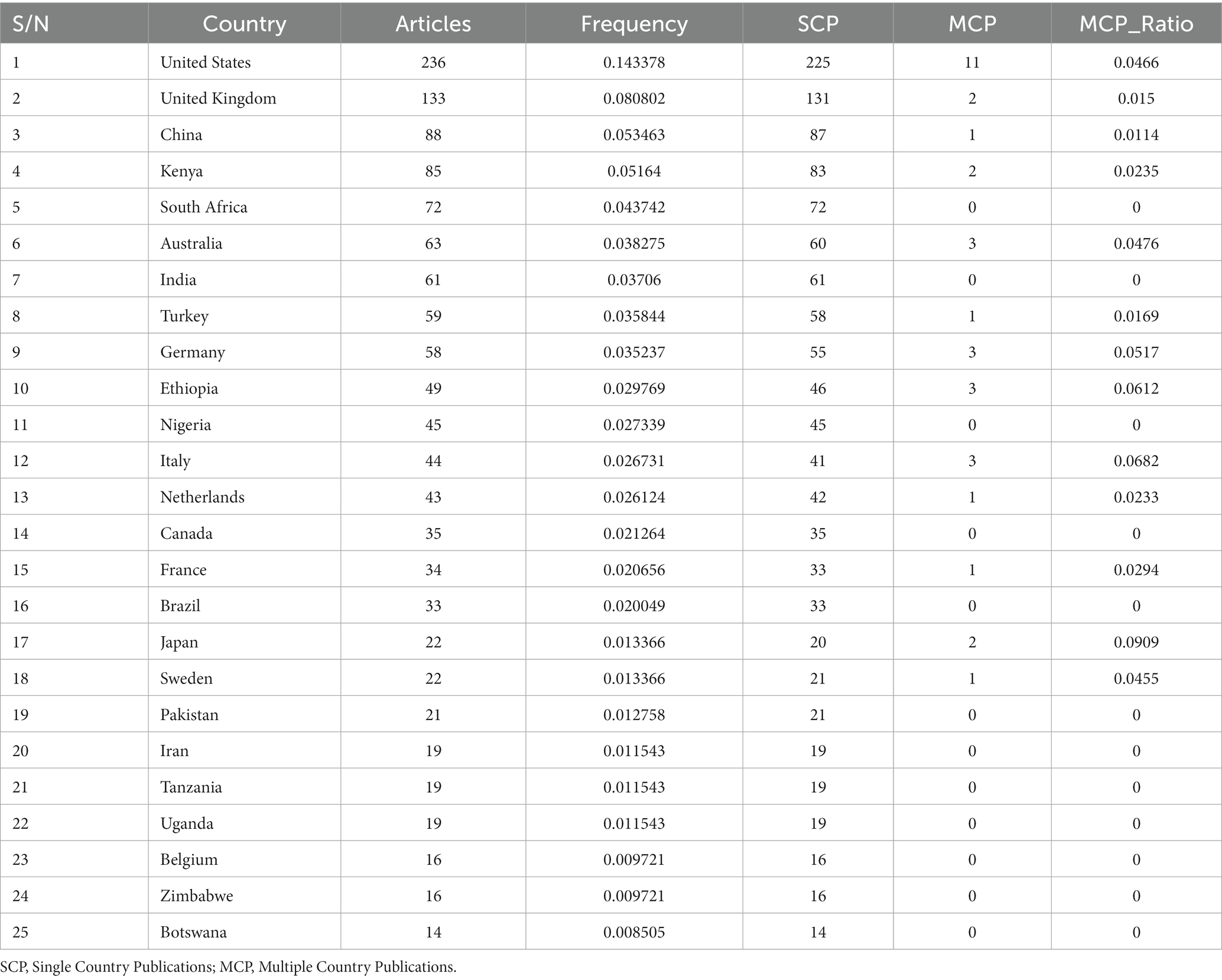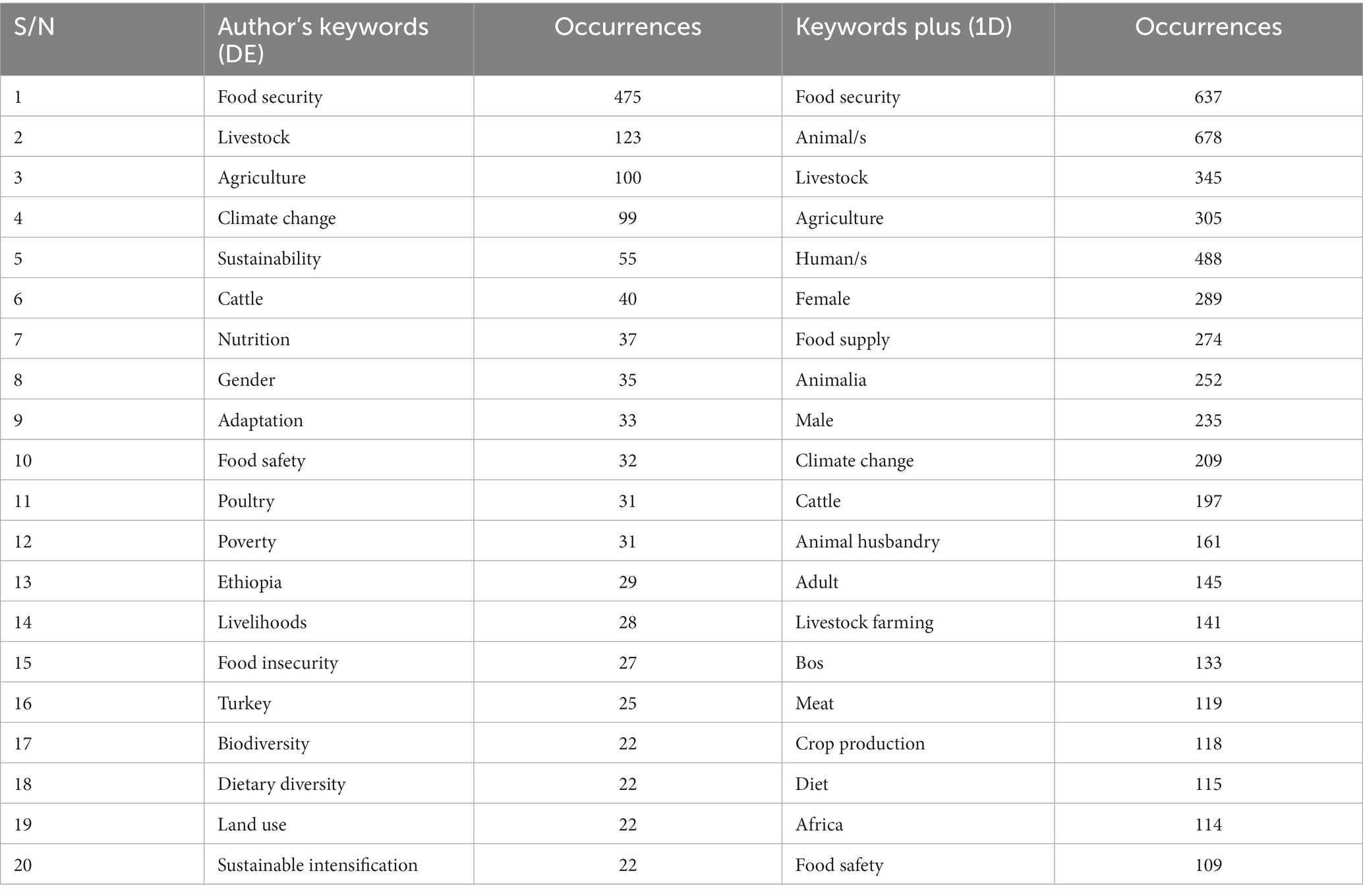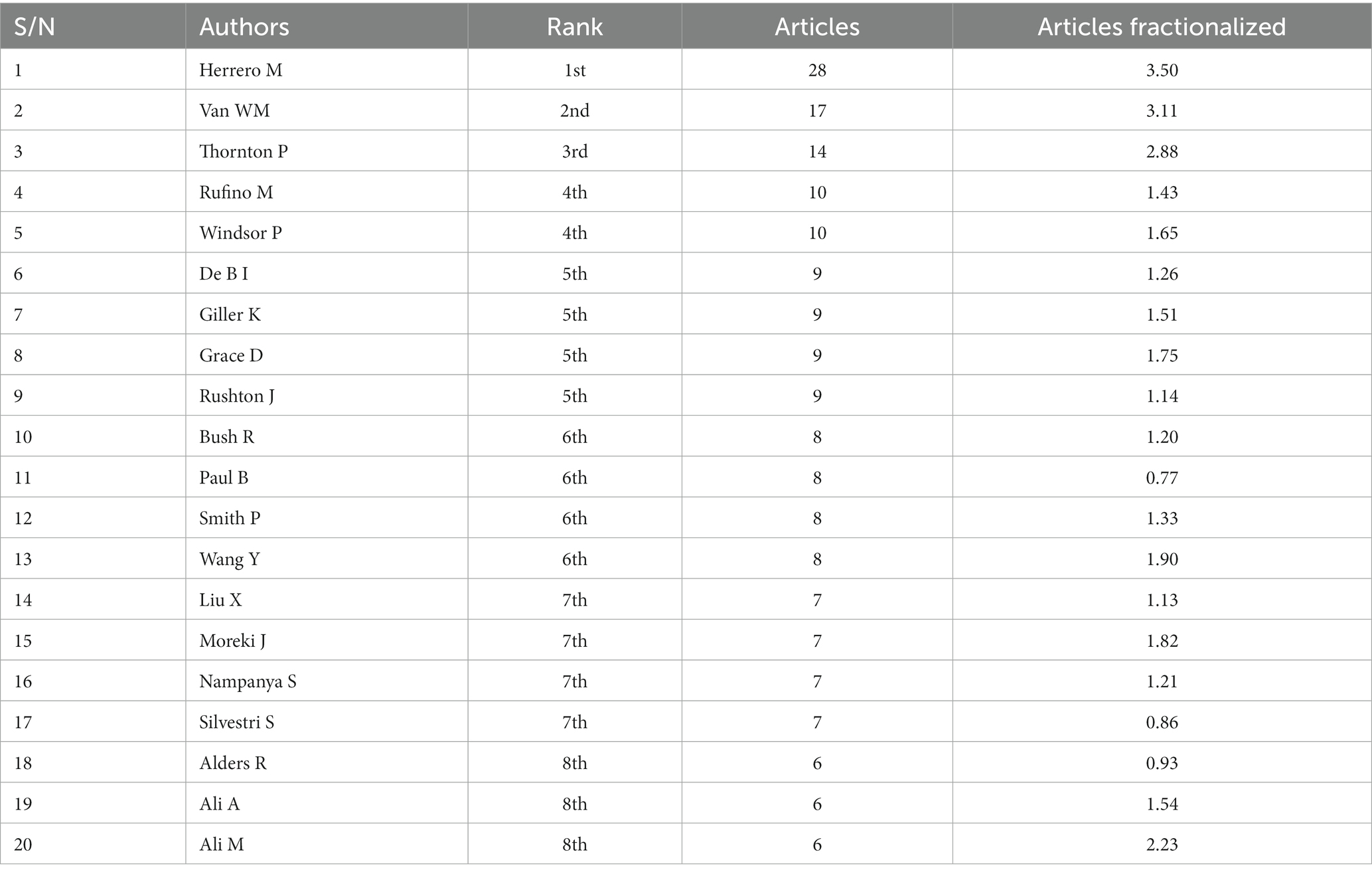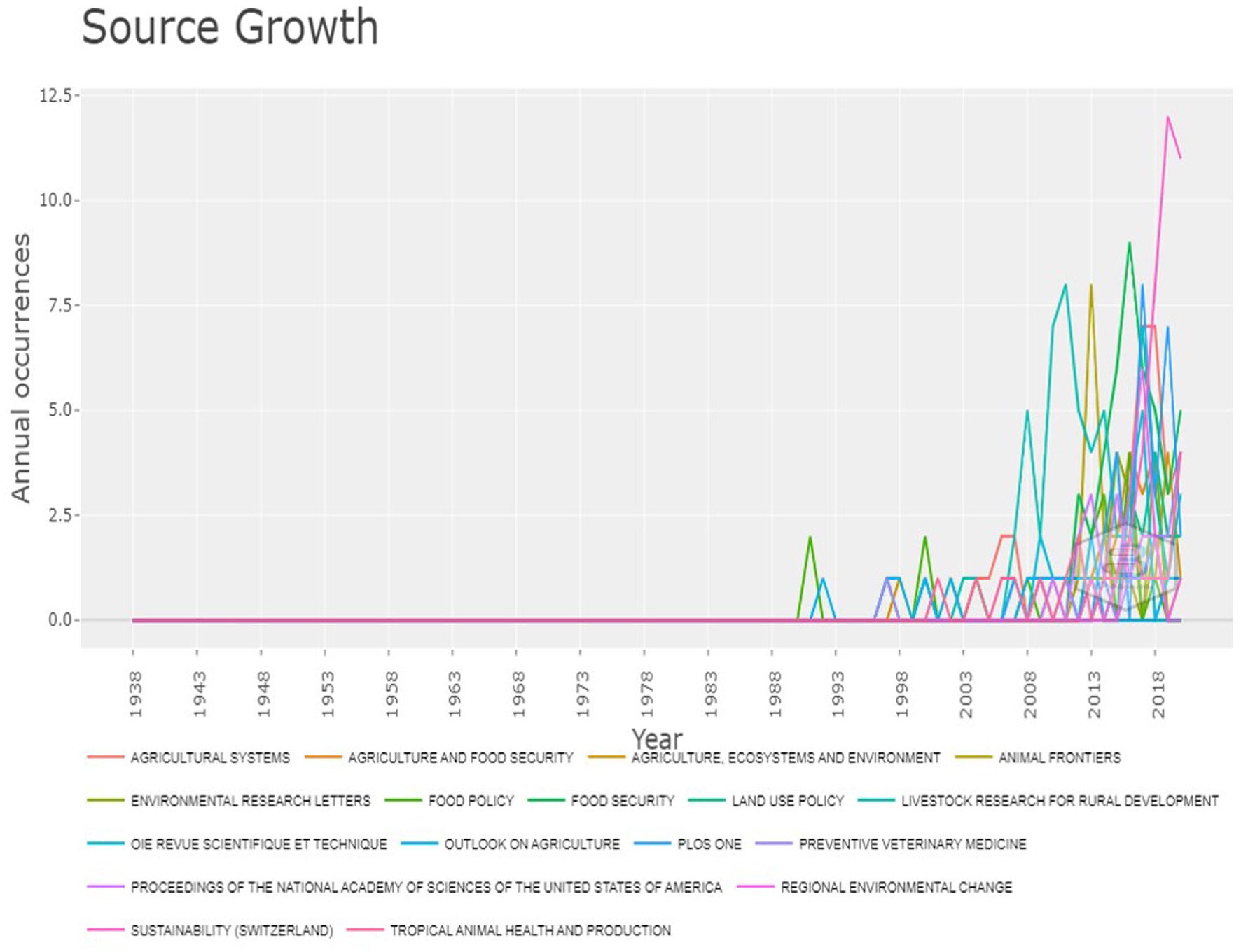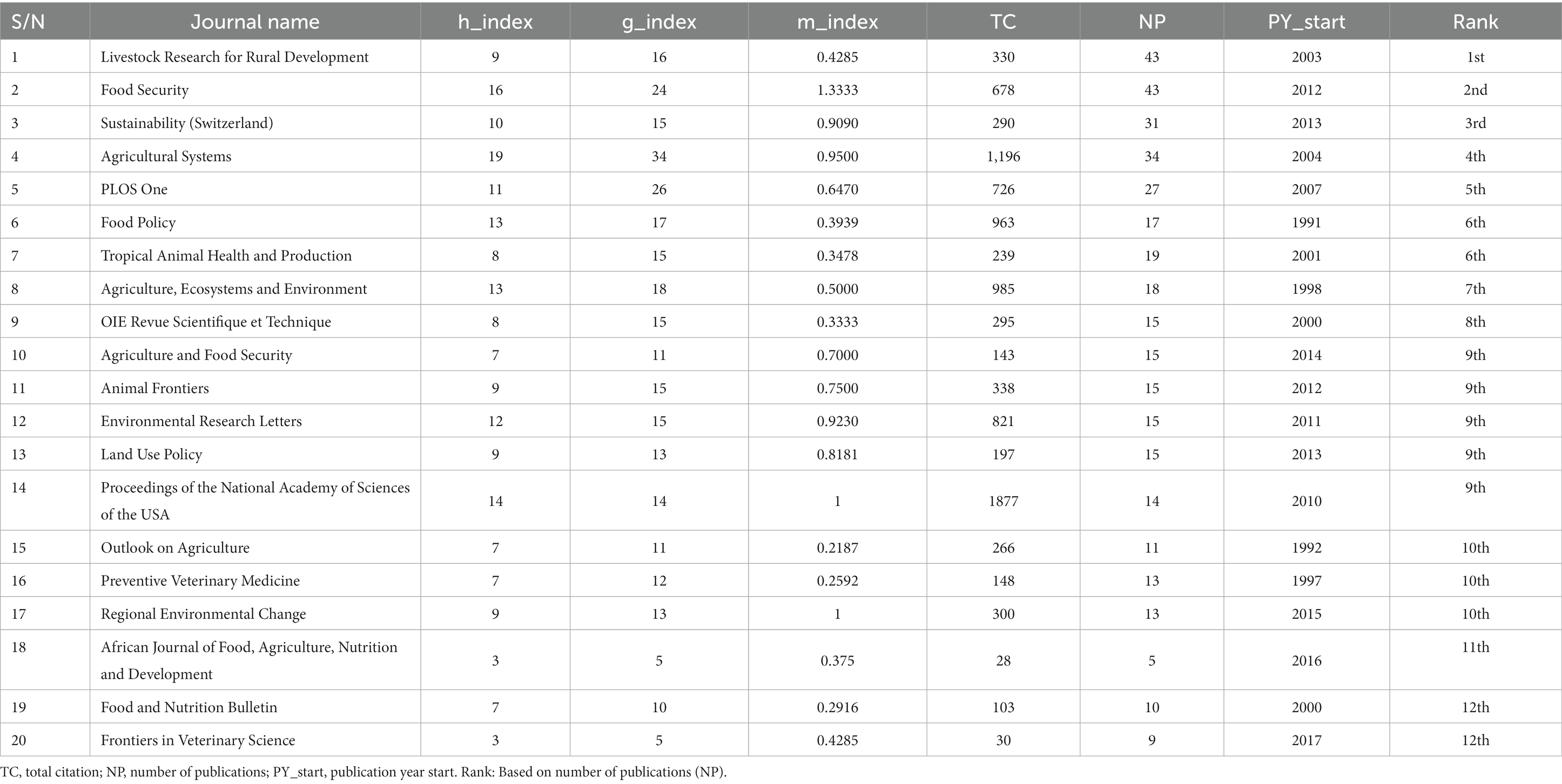- Directorate of Research and Innovation, Walter Sisulu University, Mthatha, South Africa
The present study aimed to report knowledge-based outcomes on global studies of livestock farming as a tool to address food security, while considering the recurring problems caused by malnutrition and hunger among vulnerable persons, especially in developing countries. A total of 2,012 scientific peer-reviewed studies were retrieved in BibTeX design for analysis using bibliometric collections in R studio software. The results obtained from the software included among others, authors, keywords plus, citations, collaborations, affiliations, journals, countries impact and key words. Published peer-reviewed discoveries on livestock husbandry as related to food security gathered from Scopus and the Web of Science (WOS) databanks were used, with a yearly rise in knowledge-based research of 15.04% during the timespan of the investigation. The results of the investigation revealed that the United States was ranked first with an aggregate of 236 publications [including Single Country Publications (SCP) = 225 and Multiple Country Publications (MCP) = 11] and had a huge international scientific effect with the highest article citations (n = 9,138). The most frequently used authors’ keywords in the present research niche area were food security (n = 475), livestock (n = 123), agriculture (n = 100), climate change (n = 99), sustainability (n = 55), cattle (n = 40), and nutrition (n = 37), which gave a clear direction for the related research studies regarding how livestock production can be used to enhance food security. The study in consideration presented an international picture that addresses the pool of knowledge-based, peer-reviewed findings of livestock production research and its significance to food security, while providing a clue regarding further investigations in this research niche area. It is of high essence to emphasise that the current findings solely focused on prime areas of livestock production as related to food security research; thus, it is anticipated that novel empirical research work and potential scientific findings will provide novel understanding and precision to livestock husbandry as a possible instrument to tackle the challenges of food security as new discoveries emerges.
Introduction
The subject of food security is unswervingly linked to global stability and the well-being of the general global populace, which has made the topic of food security a trending issue in virtually every part of the world. Despite the fact that the issue of global food security has been often addressed in recent times, several nations (especially developing nations from the continents of Africa and Asia among others) are still affected by serious food security challenges (FSIN, 2018). Again, the recent terrible blow experienced in most parts of the world by the outbreak of COVID-19 has negatively impacted food production and availability, making the world realize the significance of re-addressing the matter of food security yet again (Cheng and Zhu, 2020). Over 820 million people are said to be deprived of a regular daily meal, with another estimated population of over two billion people destitute of proper essential micronutrients in their daily diet worldwide (Willett et al., 2019). The recent and on-going war between Russia and Ukraine has also impacted food shortages in the global food market. With an estimated 12.5% of the global population being underfed/undernourished with regards to the energy (nutrient) intake in their diet (FAO, WFP, IFAD, 2012), it is projected that, to meet the nutritional/food demands of the world’s seven billion people, food cultivation is expected to rise by 70% (UN, 2011).
Despite the daring challenges faced in proffering solutions to reduce hunger and improve food security among the billions of people globally, the combined efforts of everyone and every stakeholder in looking for ways to ensure this reality cannot be taken lightly. One of the several measures of contending with the challenge of hunger, malnutrition, and food security (among the general populace) in affected countries and societies is to promote a food production system that is sustainable and that will meet the food demands of the world’s growing population. Livestock husbandry no doubt certainly plays a very important contributory role in realizing this goal of sustainable livelihoods and food availability for all if properly implemented and practiced in most societies of the world (Devendra, 2001).
Livestock is regarded as a vital asset in several parts of the world, especially in financially constrained societies, acting as an important food resource option in the situation where there are crop failures (IFAD, 2007; Vandamme et al., 2010), with livestock products (meat, milk, cheeses, etc.) increasing the human food resource of highly protein-rich sources/products (Kabubo-Mariara, 2009). Livestock provides diets of animal source which can offer high-quality protein and some varieties of micronutrients that are often difficult to get in adequate/correct quantities from diet of plant sources alone (Steinfield et al., 2006; Ndlovu, 2010). Livestock products account for an estimated one-third of the world’s human protein consumption in total (Popp et al., 2010). Additionally, livestock husbandry on grassland farming provides benefits that includes rangeland conservation of ecosystems, advancing of the utilization of land-preserving pastures and the production of food from abandoned lands that are unfit for crop farming (Janzen, 2011).
Other important benefits of livestock farming in promoting food security include: being a provider of employment for people and a store of financial stability (Freeman et al., 2007); it can also be used as insurance by owners (Freeman et al., 2007); and it contributes to gender equality by creating opportunities for women both young and old (Waters-Beyer and Letty, 2010). Livestock residues can also serve as an energy source for cooking, thereby contributing indirectly to food security (Moyo et al., 2007). Additionally, livestock contributes to the stability of food security of rural households by serving as an asset, a store of value, and a safety net (Pell et al., 2010).
Therefore, upholding scholarly studies on research investigations that deal with the issue of livestock farming with the aim of boosting food security or as an instrument to reduce hunger and malnutrition in the global society is very germane. Browsing through the academic literature, and hinging on the available information that is presently on the ground, there seems to be little or no research findings that have assessed scholarly publications on bibliometric discoveries on the current research topic, which pin-points the significance of this study.
Appraising research articles on livestock husbandry as a prospective instrument for advancing the issue of food security is significantly relevant with such investigations being done with the bibliometric matrix approach, which will assist institutions, governments, and policymakers among others in recognizing the current and leading research areas, global networks, country contributions, article impacts, and research directions on the topic in consideration. The most germane goal of carrying out bibliometric studies is to discuss the trends of research work, relevant research topics, top-cited topics in the niche area, local impact, international impact, global influence, and relevant authors in a given research field. A lot of well-regarded scholarly articles, such as studies by Khatun and Ahmed (2011), Ekundayo and Okoh (2018), and Xie et al. (2021), have utilized the bibliometric method to put out significant information on certain research views in different niche areas around the globe. Bibliometric research studies allow people to adopt the two-phase approach of both qualitative and quantitative media to evaluate and project the trends of research publications and citations, Largely on published scholarly articles (Palmer et al., 2005; Xie et al., 2021). In addition, qualitative bibliometric evaluation it is considered or noted to be a significant area to examine the extent of maturity and academic relevance of a particular niche area (Zhang et al., 2019).
The current research highlights some academic top subject priorities on the utilization of livestock as related to food security research work, for instance, authors, distribution of nations, research out-puts, keywords, the global trends of citations, institutions, authors’ impact, trending topics, and nations’ impact on the topic of consideration. The discoveries from this study increase the scientific knowledge archive of livestock production as a practicable instrument for addressing food security. By way of addressing the findings on academic publications, this study will assist readers in recognizing potential research gaps of livestock husbandry in the context of global food security. Furthermore, the present study will help to encourage and explore the scientific findings on livestock husbandry/production in the context of food security and applaud some plausible future research projections.
Materials and method
Analysis of data and descriptions of terms
This present study employed a bibliometrix appraisal package which is generally recognized for its accuracy. This technique is utilized to evaluate data of peer-reviewed publications such as file conversion, correspondence normalization for collaboration assessment, descriptive analysis term retraction, matrix formation, and duplicate merging and matching (Aria and Cuccurullo, 2017). The extracted data collected for this work were from academic databanks containing the names of authors, nations, the networks/collaborations of authors and nations, impact of articles, keywords plus, co-citation results, coupling, and institutions. The bibliometric diagram pairing that transpires between two scientific studies which could be depicted as “i and j” and that were cited more than once and by more than a single source were also presented (Ekundayo and Okoh, 2018). Furthermore, the sum of the bibliometric diagram pairings that resulted in the research outcomes of “i and j,” the co-authorship in networks/collaboration, and depicted the strength of the academic networking were equally presented (Aria and Cuccurullo, 2017). A specific collaboration points to the fact that there are relationships in a theme of the subject matter as a collection of nodes and networks/collaborations (Zhang et al., 2012). An authors’ impact in a given research niche is assessed as postulated in Lotka’s law, which is an inverse square law that describes the frequency of the publications of researchers in their area of expertise (Lotka, 1926).
Retrieved data preparation and analysis
Bibliometrix R package was employed to analyse retrieved data using relevant functions of the R package to explain descriptive outcomes (such as citation analysis and authors’ scientific performance). Bibliometric studies use an R studio package to interpret their results (such as citation numbers, author keywords, authors’ impact, keywords plus, authors’ collaborations, nations’ impact, and institution networks) and conduct the scientometric analysis of diagrammatic coupling (e.g., keyword co-occurrences and co-citations) of the two-way (bipartite) networking of the regular yardsticks of research publications × attributes. For instance, the mathematical explanation for a classic bibliometric collaboration/network is explained below:
where Y represents a bipartite (two pathway) network matrix involving research articles × attributes (e.g., institutions, nations, keywords, countries’ impact, authors, and article citations). N represents the symmetrical matrix N = ZT.
Conversely, the current study adopted a diagrammatic model for all networks/collaborations by employing a software language known as the force-directed Fruchterman algorithm which was inputted in the networkPlot command/function of the bibliometrix software R package. Furthermore, all the allied networks that were reported were normalized by adopting Salton’s cosine coefficient, nearness/proximity matrixes (association strength/ties), Simpson’s coefficient (inclusion matrixes), and Jaccard’s similarity/resemblance matrixes among the nodes of a network/link (Aria and Cuccurullo, 2017). Furthermore, it should be noted that the k-means clusters were done on keywords (author’s keywords) to assess concepts in livestock husbandry as related to food security by utilizing the conceptual framework command of the bibliometrix R package as was postulated by Porter’s stemming algorithm to regulate adjusted terms to their exact form (Porter, 1980).
Method of data retrieval for bibliometric analysis
Academic research findings on livestock farming and food security were used in this study. The obtained data were extracted from scientific data archives as previously mentioned [namely, the Web of Science (WOS) and Scopus] on 29 June 2021. The Scopus and WOS data banks are repositories known for first-rate scholarly and reliable academic findings (Mansoori, 2018; Repiso et al., 2018), which were used to fulfil the purpose of the intended research questions/queries of this study. The Web of Science (WOS) and Scopus were used for collecting data on livestock production (publications/articles) related to food security because both data banks encourage the formation/building of extended and combined search queries (Zhang et al., 2023). Generally, with bibliometric scientific studies, a single data archive (i.e., either the WOS, PubMed, or Scopus) can be used, because bibliometric measures and literature graphing/plotting are frequently difficult to do on research articles sourced from multiple data repositories (Sweileh, 2020). However, using a single data bank to report bibliometric findings may exclude some essential research works of the particular research questions that are intended to be solved (Zhang et al., 2023). It is therefore reasonable and justifiable to combine scientific data banks (e.g., the WOS and Scopus) that can guarantee 100% inclusion of PubMed research articles in addition to other academic discoveries/findings when doing bibliometric studies of this nature.
Search approach data gathering
A thorough search question that aligns with the associated/related collections of academic articles was done so as to prevent (to the barest minimum) pseudo-positive outcomes in this study. This was achieved by carrying out a comprehensive literature review exploration so as to get used to most of the would-be keywords linked to the searched subject matter, which is livestock farming as related to food security. The search technique adopted for this study in the data gathering has also been used in other bibliometric studies (King et al., 2018; Fesseha et al., 2020). Again, the technique used in this study in the quest for data collection was simply to utilize the title/abstract search procedure for keywords related to “livestock” and “food security.” It desired to retrieve a huge amount of unneeded articles. Therefore, to refine the title/abstract method that was employed in this study, a particular constraint was used which included the use of some specific terms associated with or related to livestock farming or food security which were also contained within the title/abstract stratagem.
Research questions/queries used for data gathering
The research queries/questions used for the present study comprised precise phrases associated with livestock farming with explicit phrases linked to food security which were inputted into the title/abstract search engine. Meanwhile, it is important to note that the livestock species covered in this study were strictly restricted to goats, sheep, cattle, poultry, chicken, and turkey, as used for the topic/title search. The present research queries were augmented by some precise terminology as a means to lessen and exclude unwanted research findings that did not meet the objective/goal of the present study. In addition, the search questions/queries that were employed in this study are presented as follows:
1. WOS.
Results: 54.
(from the Web of Science Core Collection)
You searched for: TITLE: (food securit* and (livestock* or goat* or sheep* or cattle* or poultry* or chicken* or turkey*)).
Refined by: DOCUMENT TYPES: (ARTICLE).
Timespan: 1985–2020. Indexes: SCI-EXPANDED, SSCI, A&HCI, CPCI-S, CPCI-SSH, BKCI-S, BKCI-SSH, ESCI, CCR-EXPANDED, IC.
2. SCOPUS.
2,216 document results.
TITLE-ABS-KEY (food AND securit* AND (livestock* OR goat* OR sheep* OR cattle* OR poultry* OR chicken* OR turkey*)) AND (LIMIT-TO (DOCTYPE, “ar”)).
Data analysis and processing
The present study analysed all collected peer-reviewed results/data from the WOS and Scopus banks by using R Studio v.127.0.0.1:5863 software with the bibliometrix R-package for bibliometric functions (Aria and Cuccurullo, 2017). All the collected data were transferred into R Studio and refined into the bibliographic raw-data template before they were prepared to exclude article duplications that may be inherent due to the merging of the two data banks/archives used (i.e., the WOS and Scopus). The data collection process is described in Figure 1. Furthermore, to remove replicated articles obtained from the two data banks, all similar peer-reviewed publications were constrained to just one record in this study. For better comprehension, authors’ names, keywords plus (ID), and author’s keywords (DE) were removed to understand the information stratification of this exact research subject matter (livestock husbandry and food security). Consequently, all data obtained from the WOS and Scopus were screened for inconsistencies in names, keywords, spelling errors, and author’s affiliations/nations. Looking at other parameters such as keywords (DE) and keywords-plus (ID), the theme of this study (livestock husbandry and food security) was given a primary/principal term. Again, the co-occurrence of an expression in the keywords-plus (ID set) and keywords (DE set) of authors in the data bank was analysed as a pool of data made of the two sets (ID and DE) that were merged.
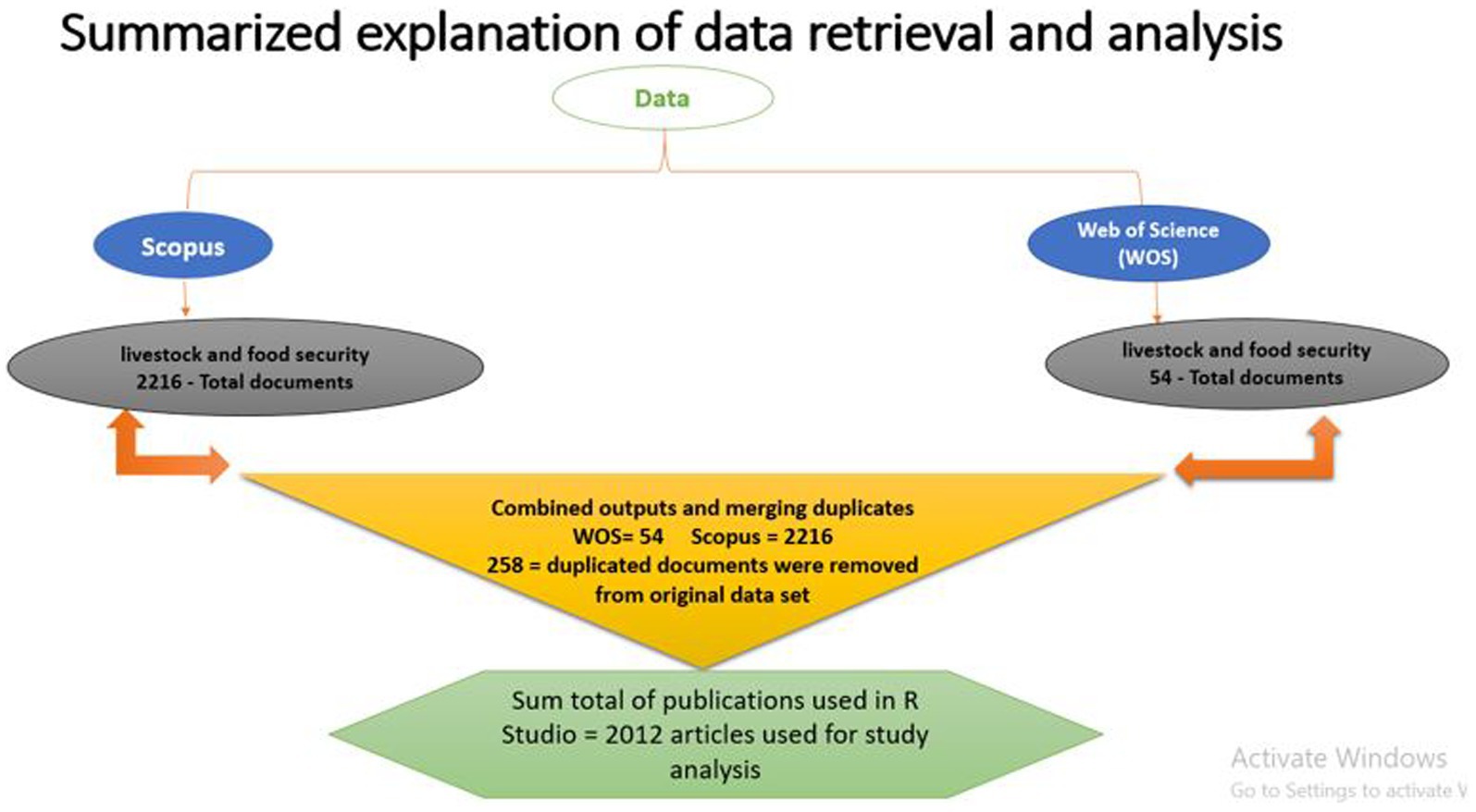
Figure 1. Diagrammatic presentation showing how data were included and exclude for articles selection.
Results
The present study found a total of 2,012 research articles in the period analyzed from the year 1938 to 2020, and the summarized results are shown in Table 1. In Table 1, there are 7,502 authors, with 274 single authors, 0.268 article publications per author (3.73 authors per research output), a collaboration matrix of 4.17, and an average of 4.4 co-authors per research article. Aside from the 274 single-author research articles, all the others (7,243) were multi-author publications. In addition, an aggregate of 19.37 citations per article/publication was documented as observed in the present investigation. Figure 2 shows on a global map the research volume associated with livestock husbandry and food security research for the 25 topmost/relevant/active nations based on their outputs. As shown in Figure 2, the United States is placed in first position by aggregate of scientific publications (n = 338), followed by the United Kingdom (n = 140), Kenya (n = 100), India (n = 90), and Australia (n = 88), respectively, among other nations. In Figure 3, the findings depict an increase in research articles on livestock husbandry and food security research with a yearly increase index of 15.04%. It can also be observed that there was little research output in terms of total publications between 1938 and 1989. Conversely, the interest in research work on livestock farming and food security started to gain momentum from 1992 at a steady rate before a sharp increase in trend after 2006 which continued until the year 2020, with a sum of over 250 research works published in 2020 (Figure 3).
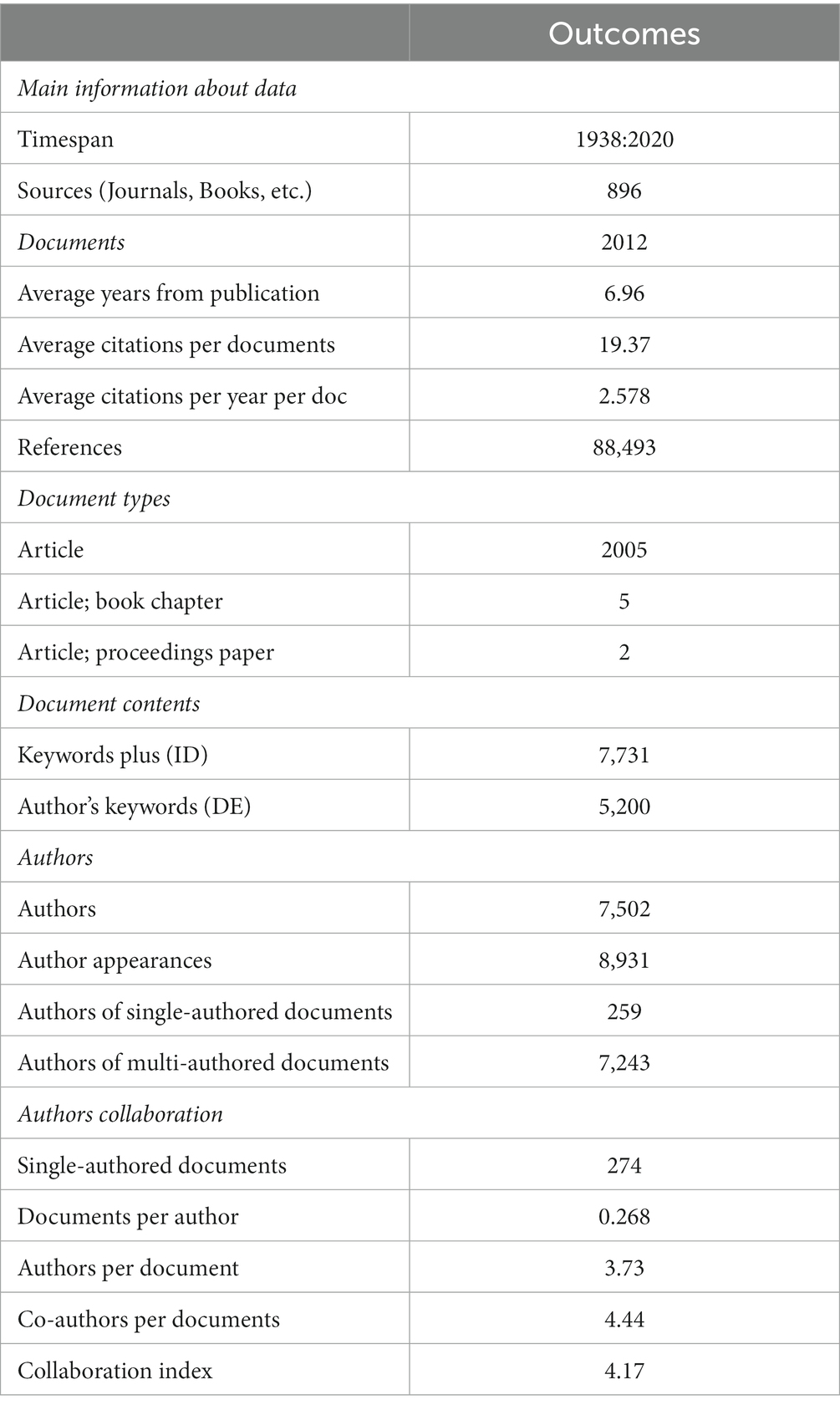
Table 1. Information of retrieved published documents on livestock production and food security from Scopus and WOS data bank.
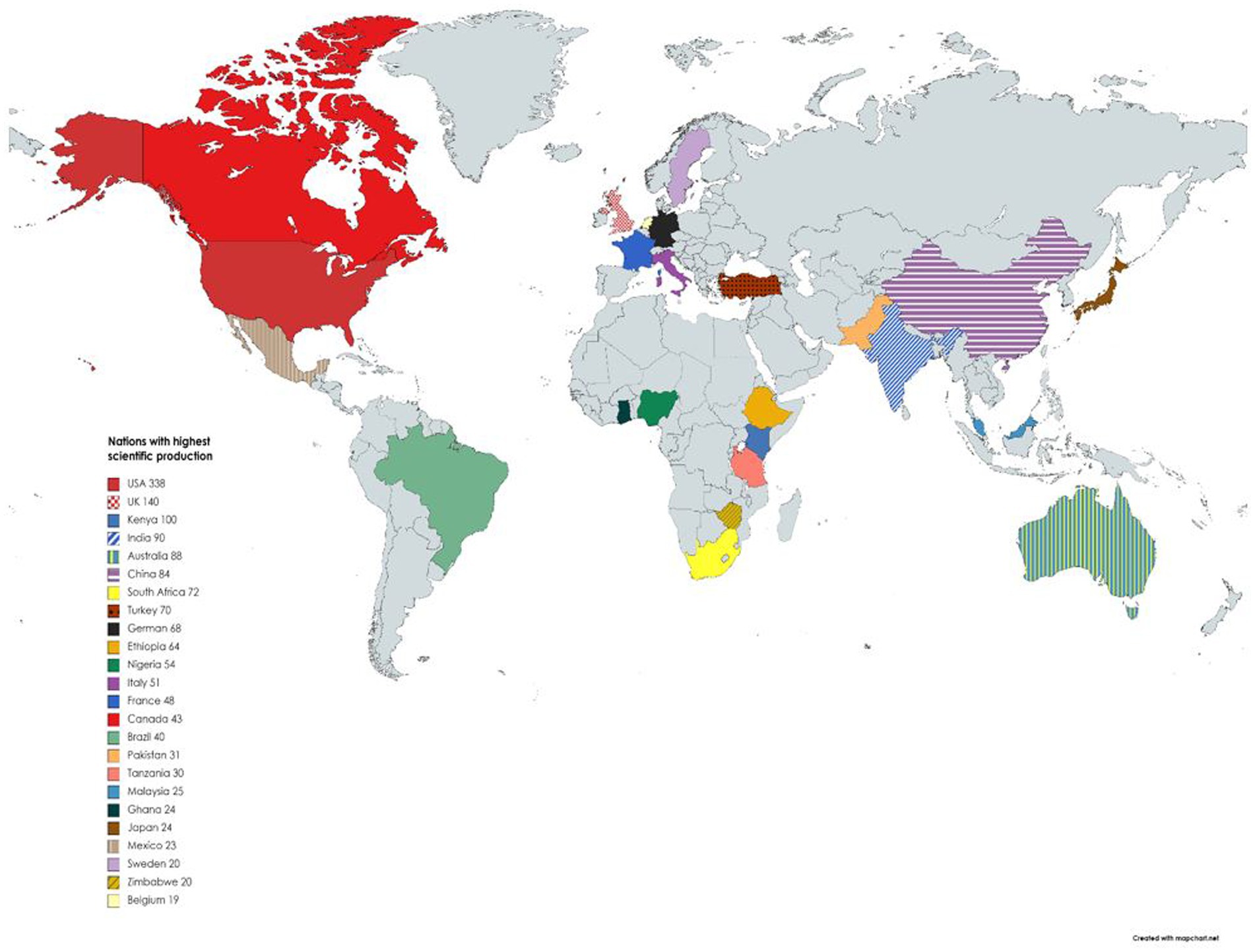
Figure 2. Spatial distribution of the 25 topmost productive nations based on number of research articles on livestock production and food security studies. Grey colour regions depict the areas that are not among the top 25 nations.
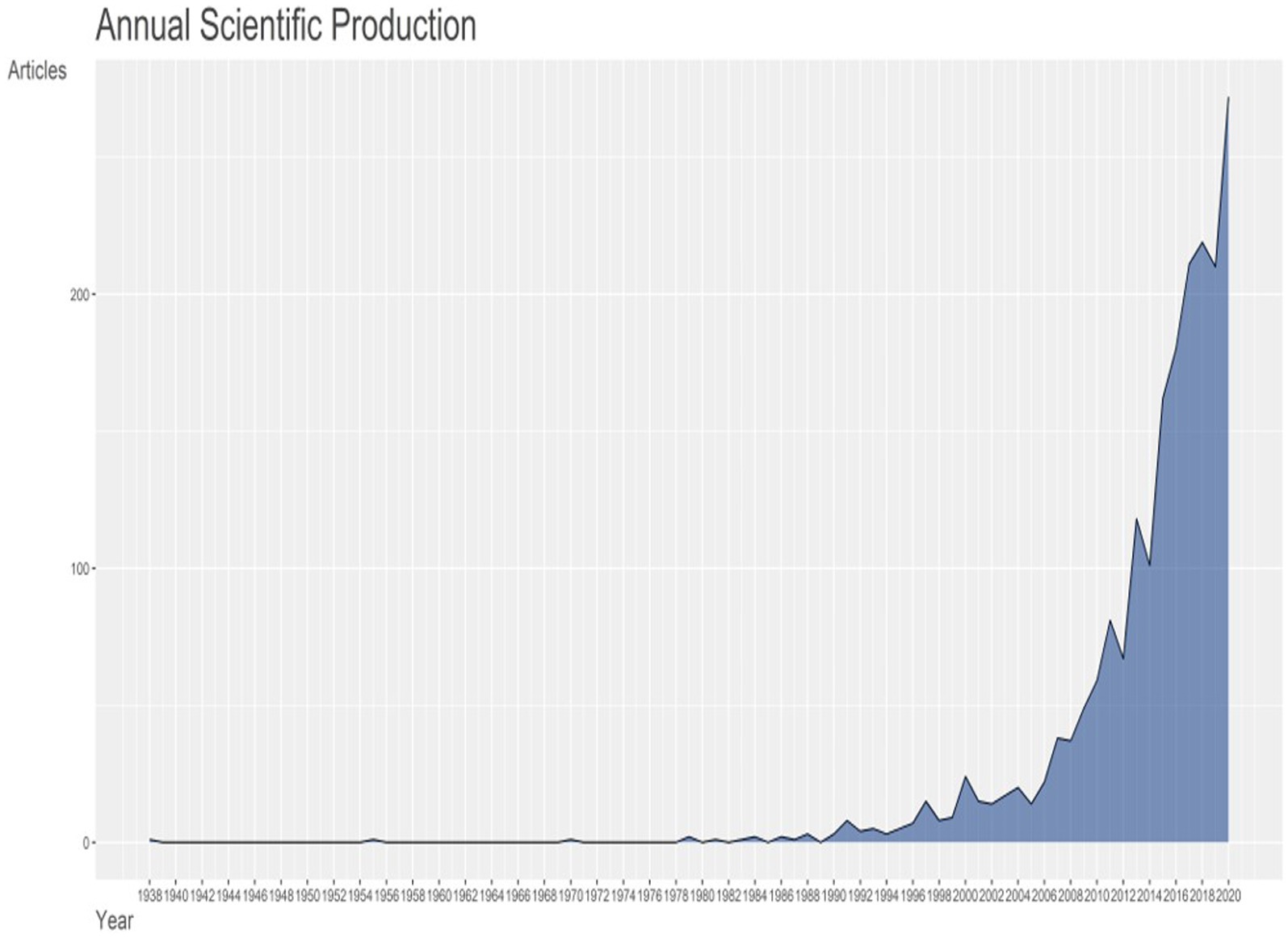
Figure 3. Yearly scientific publications (from 1938 to 2020) in livestock production and food security research studies with an annual increase rate of 15.04%. Livestock production and food security research studies depicted obvious slow or no growth from 1938 to 1990 followed by fluctuations (downward and upward trends) in research articles between 1992 and 2004 then a steady increase from 2006 to 2020.
Table 2 shows the average article citations (AAC) of the 25 topmost countries, with the most cited scientific publications in the field of livestock farming and food security research being from the United States (38.72), then the United Kingdom (38.56), Kenya (25.08), Italy (37.07), and Netherlands (28.26), respectively. The scientific publications linked to livestock production and food security research from the top 25 most productive nations is presented in Table 3. From this analysis, the United States is placed in the number one position in terms of the total number of articles (n = 236), followed by the United Kingdom (n = 133), China (n = 88), Kenya (n = 85), and South Africa (n = 72), respectively. The frequency of research output varied among these top 25 nations, from 0.008505 to 0.143378. Again, the countries ranked in the topmost position in terms of Multiple Country Publications (MCP) and networking/collaborations include the United States, which is ranked in first position (n = 11), while Australia, Germany, and Italy were ranked second (n = 3). The United Kingdom and Japan ranked third (n = 2). Meanwhile, the countries ranked in the top positions for Single Country Publications (SCP) in terms of research output in the field of livestock farming and food security research are the United States (n = 225) in first position, the United Kingdom in second position (n = 131), and China (n = 87) in third position (Table 3 and Figure 4). From what can be observed in Table 4, the most relevant author keywords in the research niche area of livestock husbandry and food security studies are: food security (n = 475) which was ranked first, followed by livestock (n = 123), agriculture (n = 100), and climate change (n = 99), among others. In Table 5, the observed results for the world’s top 20 well-known researchers in the niche area of livestock farming and food security by first author included M. Herrero in first position (n = 28) based on the amount of article publications. Additionally, W.M. Van was placed second (n = 17), followed by P. Thornton (n = 14) and M. Rufino (n = 10) who were placed in the third and fourth positions, respectively.

Table 2. The topmost 25 cited nations in relation to the average article citations (AAC) in the field of livestock production and food security from 1938 to 2020.
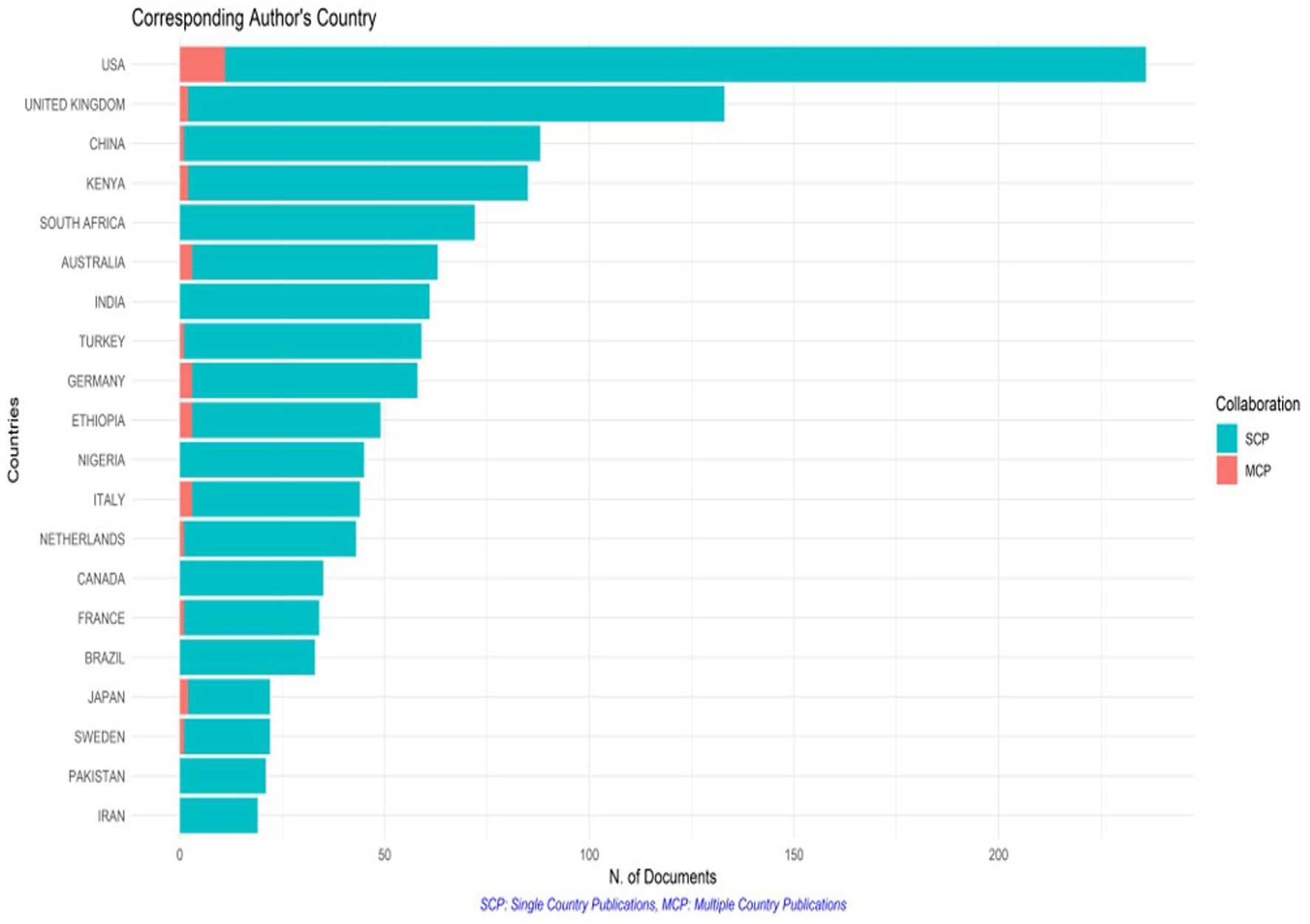
Figure 4. Most productive countries and collaboration in the research of livestock and food security from 1938 to 2020. SCP, Single Country Publications; MCP, Multiple Country Publications.
The shared conceptual frameworks of the retrieved articles was explained by k-means clustering/grouping with two groups/clusters pointing to the concepts of livestock farming (such as poultry, livestock, chickens, meat, Bos, diet) for boosting food security (e.g., food production, food supply, food security, economics, sustainability, sustainable development, climate change, human, female, smallholder, livestock farming, land use, food safety, and farming system) which are often linked to livestock farming and food security research (Figure 5). The results in Figure 6 show the keywords network visualisation of commonly recurring keywords in research on livestock farming and food security. It is vital to state that each keyword node as presented in Figure 6 shows its strength and frequency in the literature related to livestock husbandry and food security research. Furthermore, it can be deduced that the nearer the keywords are to each other, the more possibility of their interrelatedness in the literature during the study period of 1938–2020. The collaborations/network visualisation of regularly occurring keywords basically depicts the frequently used words in livestock production and food security research, which makes it simpler or easier to distinguish the niche areas of concentration in this field. The source growth of the 15 topmost productive journals is presented in Figure 7. The journals “Tropical Animal Health and Production,” “Sustainability,” “PLOS One,” “Livestock Research and Rural Development,” and ‘Food Security” have grown steadily over the last few decades in the studied subject matter. On the contrary, the impact of publications in the journals “Food Policy,” “Animal Frontiers,” and “Agriculture and Food Security” has dropped in the field of livestock over time (from 2019). Worthy of note is the fact that, between the year 1938 and 1990, a very negligible number of articles were published on livestock farming as related to food security. However, in recent years, there have been more published articles on livestock farming in the context of food security, which is a strong indication that the research niche area is gaining popularity.
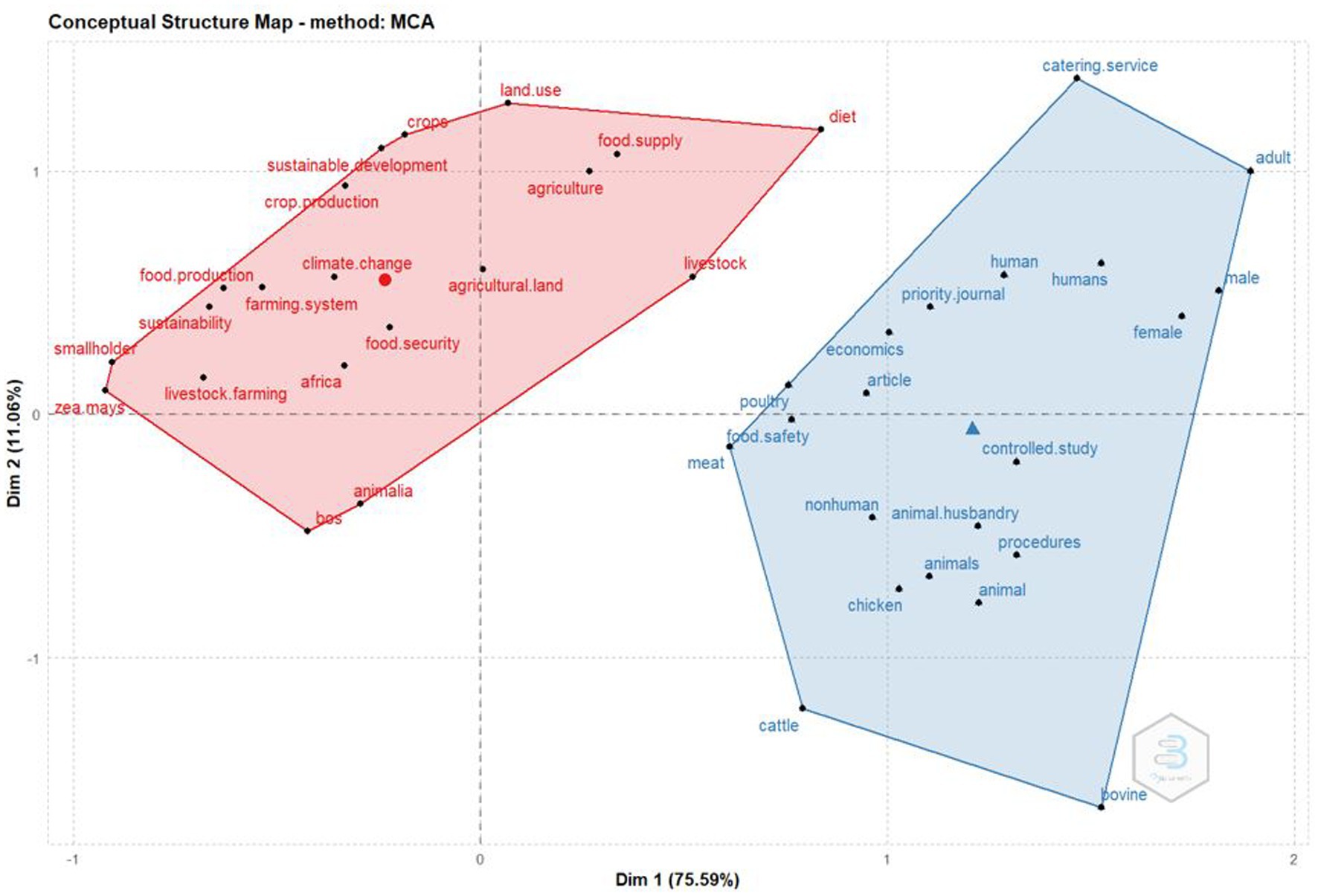
Figure 5. Common conceptual scheme associated with livestock production and food security studies. The 2012 retrieved articles indicated K-means assembling with 2 clusters depicting models of livestock production (such as poultry, livestock, chickens, meat, Bos, diet) for boosting food security (e.g., food production, food supply, food security, economics, sustainability, sustainable development, climate change, human, female, smallholder, livestock farming, land use, food safety, farming system, etc.) which are often linked to livestock and food security researches.
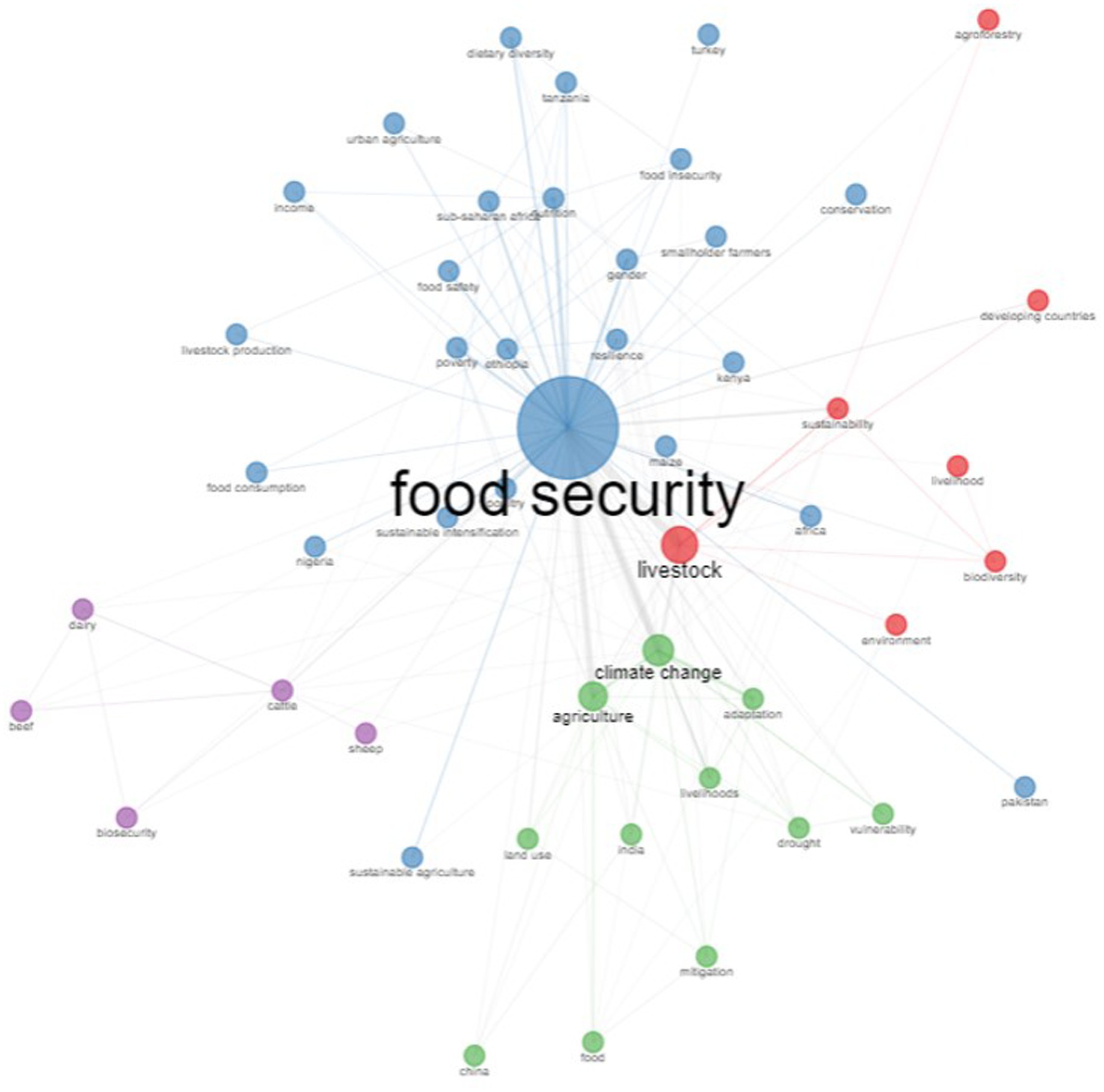
Figure 6. Keywords visualizing collaborations and network strength of international research studies on livestock production and food security. Each node in the collaboration/network shows individual keywords and the diameter of the node relates with other keyword strengths. Lines/strokes depicts the trails of association between keywords.
Table 6 shows the top 20 internationally cited publications on livestock husbandry and food security based on aggregate citations from 1938 to 2020. The article which was authored by J.A. Foley (2011) in the journal of Nature was ranked first with a total citation count of 3,631. The article that was ranked second was written by D.G. Newell (2010) in the journal of International Journal of Food Microbiology with a sum total of 655 citations. Meanwhile, the third- and fourth-placed positions were by T. Garnett (2011) and J.H. Goldstein (2012) with total citations of 487 and 410, respectively (Table 6).
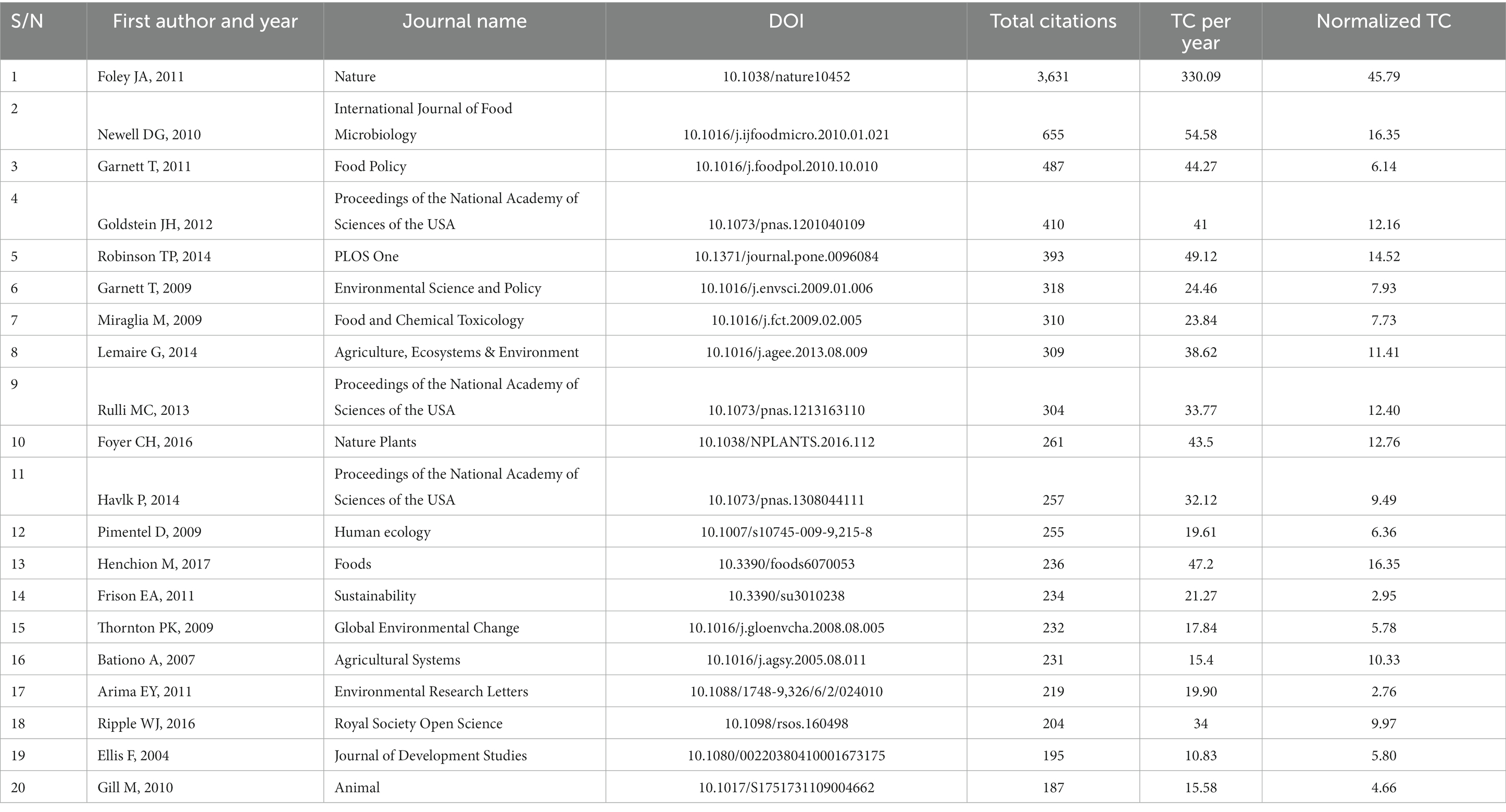
Table 6. Top 20 most internationally cited articles on livestock production and food security research from 1938 to 2020.
In addition, the top 20 relevant journals with the most published articles in the field of livestock husbandry and food security are listed in Table 7. These journals include Livestock Research for Rural Development, Food Security, Sustainability (Switzerland), Agricultural Systems, PLOS One, Food Policy, and Tropical Animal Health and Production among others. Furthermore, the journal named Livestock Research for Rural Development and Food Security was ranked first (n = 43 publications) among the journals with most published research outputs. This was followed by Agricultural Systems (N = 34) and then Sustainability (Switzerland) with 31 publications (Table 7).
The top 25 topmost prolific research institutions with at least 15 research outputs are presented in Table 8. The Wageningen University in the Netherlands (number of articles = 54) was placed in first position, the International Livestock Research Institute (ILRI) in Kenya was placed in second (number of articles = 53), the International Livestock Research Institute was placed in third (number of articles = 40), and the University of Pretoria in South Africa and the Michigan State University in United States were placed in the fourth and fifth positions (number of articles = 37 and 34), respectively.
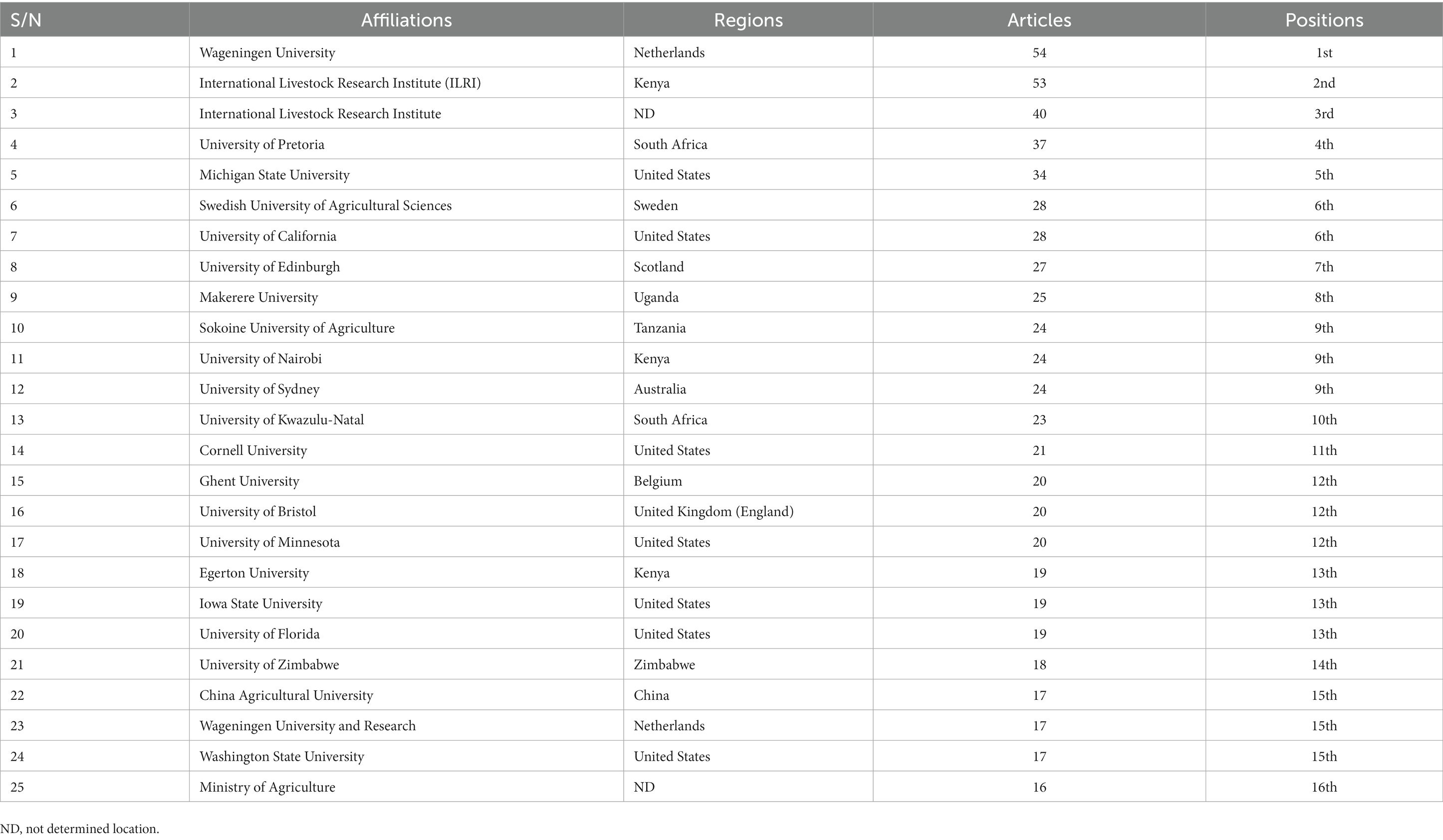
Table 8. The 25 topmost productive institutes on livestock and food security studies with over 15 articles.
Discussions
The present study regarding bibliometric research on livestock husbandry in the context of food security as a potential instrument to improve the well-being of people, especially those vulnerable and financially constrained, analyzed on the basis of data published between 1938 and 2020 and collected from the WOS and Scopus platforms. It was noticed that the amount of research done to cover the present subject matter (livestock husbandry and food security research) during earlier years (1938–1990) was not commendable despite the high premium that should have been accorded to this subject matter. However, in subsequent years, it was observed that there were appreciable improvements in the research studies/publications addressing the subject matter, which in turn resulted in a yearly growth of scientific publications of 15.04%.
The observation in the rise in academic studies/researches on livestock husbandry as a tool for enhancing food security is indicative of the belief that more scientists and research institutes have embraced the importance of studies of this nature and how they can impact the international society by tackling the challenges of hunger, malnutrition, and food security. This growing interest in more research investigations into the current subject matter may be due to several factors and not also unconnected to the reality of the immense pressure caused by the recent COVID-19 outbreak and other natural strains (e.g., wars, natural disasters, climate change, and drought) that have caused more people to be undernourished and in hunger. As part of a strategic plan to cushion the effect of food insecurity and wide-spread hunger in the world, the United Nations (UN, 2015) proposed the possibility of using livestock and its products as a significant tool to achieve its 2030 Memo for Sustainable Development, which was implemented in 2016, together with another 17 interlinked sustainable development goals (SDGs).
Several authors have described the potential of employing the use of livestock and its products (milk, meat, egg, cheese, etc.) as a source of food for vulnerable people (Delgadillo-Puga et al., 2020; Yusni and Maryatun, 2021), as micro-nutrient enhancers in diets (Engh et al., 2000; Kabubo-Mariara, 2009), as a provider of employment (Waters-Beyer and Letty, 2010), as a means for revenue generation (IFAD, 2007; Vandamme et al., 2010; Hayaloglu and Karagul-Yuceer, 2011), and as a platform to advance the economic/financial resilience of financially constrained persons (Freeman et al., 2007; Silanikove et al., 2010; Milani and Wendorff, 2011). Furthermore, from the yearly upsurge in academic production observed in Figure 3 (a yearly rise of 15.04%), it may be safe to state that more scientific investigations into the utilization of livestock husbandry to address the menace posed by a lack of food and prevalent hunger will further rise in the future. It is important to mention the fact that, with the rise in food prices and increased situations of hunger, malnutrition, and food shortages in several nations of the world (Béné et al., 2021), the push by scientists and research institutes will increase toward doing more investigations into improving livestock production, which is likely to be supported and aided by policies by the governments of nations, the United Nations, and other sister agencies like the FAO.
As widely anticipated, and in agreement with other research niche areas (Ekundayo and Okoh, 2018; Orimoloye and Ololade, 2021), it was observed in the current study that many of the most relevant authors promoting research investigations into the present subject matter are from developed countries, with few from economically constrained nations. This finding is contrary to the study by Idamokoro and Hosu (2022a), who observed that many of the recognized authors from their bibliometric analysis study on the use of village chicken to promote food security were from developing nations and especially from Africa.
In agreement with the findings of the present study, previous reports of bibliometric studies from authors who assessed studies in other fields often discovered that knowledge drivers (researchers) of most bibliometric studies are from countries with financially stable economies such as the United States, United Kingdom, Australia, and China, with very few contributions coming from authors based in developing/low-income countries (Orimoloye and Ololade, 2021; Smith et al., 2021; Tywabi-Ngeva et al., 2022). The foremost countries with networks/collaborations on livestock husbandry and food security research mostly networked or formed alliances with other developed countries, while on few occasions they networked with authors from other developing nations whose governments give little or no attention and sponsorship to research work that has the potential of positively impacting their countries’ economies and knowledge advancement.
With respect to the amount of research output, nations from stable economies (e.g., the United Kingdom, United States, and China) usually show dominance on the international stage (Geaney et al., 2015; Bruggmann et al., 2017; Idamokoro and Hosu, 2022b). In addition, these developed nations tend to network and collaborate in the area of research with other developed countries thereby neglecting nations from developing societies (Orimoloye and Ololade, 2021; Smith et al., 2021; Tywabi-Ngeva et al., 2022). Alliances between developed and developing nations are rare in scholarly studies (Orimoloye and Ololade, 2021). The promotion of research investigations/studies that involve collaborations and possible networking by both intra- and international research institutions among developing and developed nations should be highly encouraged and well embraced (Ekundayo and Okoh, 2018), as this could boost some privileges in harnessing resources such as finances and equipment to tackle essential research questions that will answer global questions on human well-being and food availability.
The economic prowess of any nation is a supporting factor that boosts their interest in research precedences and involvement (Peng et al., 2015). The present intercontinental challenge with regards to hunger, malnutrition, food security, and poverty in several financially struggling countries should aggravate the need for more initiative by researchers and the governments in these countries to explore the potential of doing more scientific research on livestock production as a tactical and strategic means for enhancing food availability and security. Livestock farming offers people with a wide-range of choices in terms of their products (e.g., meat, milk, cheese, yoghurt, and butter) and socio-economic services as related to food security. The idea of becoming either a part-time or full-time livestock farmer (as either part-time or full-time) by rearing domesticated animals (such as chickens, goats, sheep, cattle, and turkeys) makes the craft easily adoptable for various categories of persons, including young people and women. The practice of livestock farming can be done at large-, medium-, or small-scale levels, making it a viable and sustainable tool for addressing food security issues if the right management practices are put in place.
The utilization of livestock for boosting food security plays a significant part in the social life of a lot of people in the developing world, especially in Africa (Peacock, 1996; IFAD, 2007; Vandamme et al., 2010). Thus, the social and economic relevance of livestock in terms of what they add (milk, meat, skin, yoghurt, etc.) to the economic and social benefits of several populations of the world makes them vehicles of development in areas that are mostly hit by food security crises, especially in Africa (Ngambi et al., 2013).
Small ruminant livestock husbandry like goat farming, for example, produces milk which is utilized for food and revenue creation in the Middle East, Eastern Europe, the Mediterranean, and some parts of South America (Ribeiro and Ribeiro, 2010). Furthermore, livestock plays an essential role in promoting the security of financially struggling family units who see livestock as the only asset that they possess (Seré, 2004; Silanikove et al., 2010; Milani and Wendorff, 2011). Animal-based food ingredients are a vital source of the protein required in the human diet. The common/regular practice of the inclusion of some quantities of milk to children and adults’ diets meal in some cultures from household livestock (e.g., cow or goat) owners in countries in sub-Saharan Africa such as Kenya, Benin, Malawi, and South Africa is a testament to its nutritional value (Neumann et al., 2003; Dossa et al., 2015; Idamokoro et al., 2019; Kaumbata et al., 2020). According to the report by Neumann et al. (2003), it was said that goat milk fed to children enhanced the performance, and improved the cognitive ability functioning and activity rates of children.
The United States, United Kingdom, China, Kenya, and South Africa are among the nations in the topmost positions that are productive in terms of research output on livestock husbandry and food security with regards to the total article productions (Table 3). One important reason for any country to have more article numbers in a particular research field is because of their priority for that research subject and the nations’ financial ability to do such research (Peng et al., 2015; Zyoud, 2017). The United States is often reported to be a country with the most multiple partners in international networking in promoting research on sustainable livelihood and human wellness (Zhang et al., 2019). The reason why this is so is chiefly because the United States recognizes the significance of early interventions on sustainable development and improved livelihood as it relates to food security; they are always willing to employ resources to support such projects at all cost. However, it is necessary to pin-point the fact that the results observed from the present study also listed some developing nations (e.g., Kenya and South Africa in third and fourth positions, respectively) in the top list that promotes research on livestock farming, which suggests the essential perspective of the importance of the current subject matter in addressing food security in these two nations (Kenya and South Africa).
There were very few nations that were observed to have multiple country collaboration (MCP) on livestock farming as linked to food security research, with only the United States showing a clear high figure (n = 11) of multiple country collaborations, as seen in Table 3. This further establishes the fact that the United States is a committed nation when it comes to research interests that deals with promoting food availability and security for its citizens. Again, from most bibliometric studies, the United States is known to dominate in the area of multiple country publications, as was also observed in the present study. However, on the contrary to the present study, in the bibliometric study by Smith et al. (2021) on green bio-pesticide research, it was observed that Italy was ranked first with respect to research on green bio-pesticide. Conversely, judging from the annual growth rate of scientific research articles (15.04%), it could be said that more nations may also increase their involvement in doing research in line with the current topic.
A visible observation was made from the present study with regard to highly published nations swapping positions in the results for the most highly cited (total citations) nations in research on livestock husbandry and food security (Tables 2 3). This obvious observation is similar to findings from other bibliometric research work (Ekundayo and Okoh, 2018; Orimoloye and Ololade, 2021). The reason for this swapping of position in the nation rankings when they are used to review countries’ performance may show its unreliability as an effective tool to determine the productivity of nations in that respect. According to Fricke et al. (2013), it was reported that the amount of citations of a given nation does not reflect the article publications of that nation. The reason stated by Fricke et al. (2013) was due to the fact that the lower the amount of research articles utilized for bibliometric study evaluation, the higher the impact of a few regularly cited articles. This is because a lot of researchers/authors normally use self-citations, and some authors give incorrect citations of other authors’ publications when presenting their research findings; this in turn may lead to inaccurate qualitative and quantitative metrics of the aggregate citations of a certain nation (Ekundayo and Okoh, 2018).
The most frequently used keywords and research areas linked with livestock farming and food security research showed the trending topics of this study which included food security, livestock, agriculture, climate change, sustainability, cattle, nutrition, gender, adaptation, food safety, poultry, and poverty among others (Table 4). These reveal the fact that these key words are themes that promote research and interventions that will tackle the issues of hunger, malnutrition, and food security, which appear to be major global challenges for most populations in several nations, especially the financially constrained ones.
In addition, the keywords and research focus as visualized in this present study divulged some important efforts that have been made by researchers in this niche area to inspire more research investigations into the utilization of livestock husbandry as an effective research tool for unravelling some of the mysteries inherent in the menace of food security and hunger among vulnerable people. Importantly, keywords are meant to encapsulate the core focus of a particular body of knowledge, and it helps to emphasis and refine the vital concepts of the studied research topic (Chen et al., 2014).
According to the number of article publications from the WOS and Scopus archives, M. Herrero (n = 28) had the highest number of publications relating to livestock and food security, followed by W.M. Van (n = 17), and P. Thornton (n = 14), respectively (Table 5). M. Herrero is a well-known author in the area of food security research who has made significant contributions to this field (Xie et al., 2021). According to Xie et al. (2021), the work of M. Herrero on food security research has earned him a h-index with a value of up to 9, signifying his academic influence in the research society globally.
From the top 20 journals that featured visibly (with highest numbers of publications and citations) in the studies on livestock and food security, journals including Livestock Research for Rural Development, Food Security, Sustainability (Switzerland), Agricultural Systems, PLOS One, Food Policy, and Tropical Animal Health and Production were highlighted on the top list (Table 7). These journal publishers are well-known for disseminating academic findings that are associated with livestock husbandry with the sole aim of promoting food cultivation and food security (Aklilu et al., 2007; Dumas et al., 2016; Desta, 2021). Considering the relevance of the present subject matter, more journals should be encouraged to support the research work done on livestock husbandry and food security. This will further cement the calls from the United Nations and Food and Agricultural Organization (UN, 2015; FAO, 2017), whose agencies have been advocating for the need for scientists/institutions to work more on contemporary trending issues related to livestock production and food security due to the persistent global food challenges.
With regards to international networking and alliances, authors generally employ phrases such as “global co-publication” or “global articles” for articles that are published via the collaboration of academic scientists from various countries so as to have a stronger research output and impact. The present assessment (Figure 4) showed the international cooperation ties for 20 leading countries involved in livestock husbandry and food security research. Assessing bibliometric studies from an international standpoint, it is instructive to note that the leading research nations often practice a cordial alliance with other nations regarding research questions that are of mutual interest and importance to them (Zhang et al., 2019). Research collaborations/networking among authors and nations in most cases results in a positive and important scientific impact on published output (Van Raan, 2004).
The United States of America dominated among the countries that had research institutions with majority of co-author around the world in the area of livestock farming and food security research. Other economically stable nations (e.g., Netherlands, United Kingdom, Australia, and China) also made up the numbers of the top institutions with high numbers of international co-authorships/networks. Similar findings from previous studies also showed that countries of a financially stable state have academic institutions associated with global networking and co-authorship in several other research niche areas (Zyoud, 2017; Idamokoro and Hosu, 2022c). Among the nations with leading co-authorships/networks are Kenya, Uganda, Tanzania, Zimbabwe, and South Africa, which is a somewhat rare scenario, but nevertheless a commendable one for these nations especially because of the high numbers of vulnerable (food insecure) people in these nations as compared to those in the developed countries.
More research on improving livestock production and management practices with the goals of boosting human welfare and curtailing the threat of hunger, malnutrition, and food security at a more aggressive pace is worth the while. Bibliometric analysis together with meta-analysis studies on livestock farming and food security research will be of valuable essence to the already profiled study in this research niche.
At the moment, this article appears to be the first bibliometric investigation to convey the research studies on livestock farming as related to food security at an international level. However, it should be acknowledged that there may be some short-comings/limitations to the study including but not limited to:
i. Missing articles that were not recovered in the assessment process of livestock husbandry and food security studies or their related key words during the data collection process from the WOS and Scopus.
ii. Some constraints may have been reflected in this study since publications on livestock farming in the context of food security studies that were in non-indexed publication outlets/journals were not included, perhaps because they were unavailable in the data banks of Scopus and the WOS, for example, papers written in other non-English languages.
iii. Furthermore, this study may have a shortfall related to the removal of other publication types, such as conference abstracts and note articles.
Conclusion
The bibliometric assessment of the present study revealed an essential rise in the use of livestock as a potential instrument to tackle the challenges of hunger, malnutrition, and food security, with more large research investigations being done in well-developed nations (also known as high-income countries) in comparison to developing nations (also known as low- and middle-income countries). Several developing nations such as Kenya, South Africa, Nigeria, and Ethiopia have also joined the numbers of countries that have embraced the need to adopt the strategy of using livestock for addressing the challenges of food security, malnutrition, and hunger. The high numbers of investigations carried out in developed nations on this subject matter show their commitment toward addressing the menace of hunger, malnutrition, and food security among their growing populations in the 21st century in comparison to the case for developing countries, especially in Africa and Asia. However, despite the considerable improvements illustrating the adoption of livestock production as an important tool for food security and hunger alleviation over the past eighty decades, a lot of work is still needed to be done if the situation of global food security and hunger/malnutrition are to be conquered; the reason is not unconnected to the recent global setback caused by COVID-19 and economic recessions, leading to more people being exposed to hunger and a lack of quality food. In order to achieve this, more collaborations and research investigations championed by financially stable nations with developing nations should be intensified and encouraged.
Future perspectives on livestock and food security research
Although more nations, especially developing nations, are now very conscious of the problem of hunger and food shortages, with regards to a problem-solving evolutionary pathway, the subject of livestock and food security research in developing countries can further be improved through the instrumentality of smart urban livestock farming. Likewise, to tackle the issues of climate change and poverty that are known to be a threatening clog in the wheel of food security, the adoption of sustainable development and strategic intervention programs should be employed to further improve the production of more livestock products for human utilization. Furthermore, it will be very important to state that the subject of livestock farming and food security research precede just a sole-subject matter should move toward the intersection/inter-collaborations with other research disciplines such as environmental science, sociology, demography, and other research fields. With the intersection of other research disciplines, the present subject of livestock husbandry as linked to food security research should be entirely carried out in the field together with research on the ecological, economic, and social levels of people in order to improve the theoretical framework and norms of the present subject matter. In the future, research on livestock husbandry and food security should give more recognition to sustainable development of inter-discipline, multi-discipline research and coordination among the economy and society with the support of technological advancements and workable policy management systems.
Data availability statement
The raw data supporting the conclusions of this article will be made available by the authors, without undue reservation.
Author contributions
EI: conceptualization, data curation, analysis, visualization, writing original draft, and manuscript editing.
Acknowledgments
The author would like to specially thank Dr. C.T. Ekundayo for his intellectual input in the writing of this paper.
Conflict of interest
The author declares that the research was conducted in the absence of any commercial or financial relationships that could be construed as a potential conflict of interest.
Publisher’s note
All claims expressed in this article are solely those of the authors and do not necessarily represent those of their affiliated organizations, or those of the publisher, the editors and the reviewers. Any product that may be evaluated in this article, or claim that may be made by its manufacturer, is not guaranteed or endorsed by the publisher.
References
Aklilu, H. A., Almekinders, C. J., Udo, H. M., and Van der Zijpp, A. J. (2007). Village poultry consumption and marketing in relation to gender, religious festivals and market access. Trop. Anim. Health Prod. 39, 165–177. doi: 10.1007/s11250-007-9002-8
Aria, M., and Cuccurullo, C. (2017). Bibliometrix: an R-tool for comprehensive science mapping analysis. J. Informet. 11, 959–975. doi: 10.1016/j.joi.2017.08.007
Béné, C., Bakker, D., Chavarro, M. J., Even, B., Melo, J., and Sonneveld, A. (2021). Global assessment of the impacts of COVID-19 on food security. Glob. Food Sec. 31:100575. doi: 10.1016/j.gfs.2021.100575
Bruggmann, D., Maule, L. S., Klingelhofer, D., Schoffel, N., Gerber, A., Jaque, J. M., et al. (2017). World-wide architecture of osteoporosis research: density-equalizing mapping studies and gender analysis. Climacteric 19, 463–470. doi: 10.1080/13697137.2016.1200548
Chen, Y., Chen, C.M., and andc Hu, Z.G., (2014). The principle and application of citation spatial analysis ; Science Press: Beijing, China.
Cheng, G. Q., and Zhu, M. D. (2020). The impact of the COVID-19 on food security: trend, impact and countermeasures. China’s Rural Econ. 425, 16–23.
Delgadillo-Puga, C., Noriega, L. G., Morales-Romero, A. M., Nieto-Camacho, A., Granados-Portillo, O., Rodríguez-López, L. A., et al. (2020). Goat’s Milk intake prevents obesity, hepatic steatosis and insulin resistance in mice fed a high-fat diet by reducing inflammatory markers and increasing energy expenditure and mitochondrial content in skeletal muscle. Int. J. Mol. Sci. 21, 5530–5556. doi: 10.3390/ijms21155530
Desta, T. T. (2021). Indigenous village chicken production: a tool for poverty alleviation, the empowerment of women, and rural development. Trop. Anim. Health Prod. 53, 1–16. doi: 10.1007/s11250-020-02433-0
Devendra, C. (2001). Small ruminants: imperatives for productivity enhancement, improved livelihoods and rural growth – a review. Asian-Australas. J. Anim. Sci. 14, 1483–1496. doi: 10.5713/ajas.2001.1483
Dossa, L. H., Sangaré, M., Buerkert, A., and Schlecht, E. (2015). Production objectives and breeding practices of urban goat and sheep keepers in West Africa: regional analysis and implications for the development of supportive breeding programs. SpringerPlus 4, 1–12. doi: 10.1186/s40064-015-1075-7
Dumas, S. E., Lungu, L., Mulambya, N., Daka, W., McDonald, E., Steubing, E., et al. (2016). Sustainable smallholder poultry interventions to promote food security and social, agricultural, and ecological resilience in the Luangwa Valley, Zambia. Food Secur. 8, 507–520. doi: 10.1007/s12571-016-0579-5
Ekundayo, T. C., and Okoh, A. I. (2018). A global bibliometric analysis of plesiomonas-related research (1990 – 2017). PLoS One 13, 1–17. doi: 10.1371/journal.pone.0207655
Engh, I., Stloukal, L., and De Guerny, L. (2000). HIV/AIDS in Namibia: the impact on the livestock sector. FAO, Rome.
FAO, WFP, IFAD (2012). The state of food insecurity in the world 2012. Economic growth is necessary but not sufficient to accelerate reduction of hunger and malnutrition. FAO, Rome, Italy.
Fesseha, H., Degu, T., and Getachew, Y. (2020). Nanotechnology and its application in animal production: a review. Vet. Med. Open J. 5, 43–50. doi: 10.17140/VMOJ-5-148
Food Security Information Network (FSIN). (2018). Global report on food crisis. FSIN, Rome, Italy, pg. 202.
Freeman, A., Kaitibie, S., Moyo, S., and Perry, B. (2007). Livestock, livelihoods and vulnerability in selected SADC countries (Lesotho, Malawi and Zambia). ILRI Research Report 8. ILRI, Nairobi, Kenya.
Fricke, R., Uibel, S., Klingelhoefer, D., and Groneberg, D. A. (2013). Influenza: a scientometric and density-equalizing analysis. BMC Infect. Dis. 13, 454–461. doi: 10.1186/1471-2334-13-454
Geaney, F., Scutaru, C., Kelly, C., Glynn, R. W., and Perry, I. J. (2015). Type 2 diabetes research yield, 1951–2012: bibliometrics analysis and density-equalizing mapping. PLoS One 10, 1–14. doi: 10.1371/journal.pone.0133009
Hayaloglu, A. A., and Karagul-Yuceer, Y. (2011). Utilization and characterization of small ruminants’ milk and milk products in Turkey: Current status and new perspectives. Small Ruminant Research 101, 73–83.
Idamokoro, E. M., Gunya, B., and Aliber, M. (2019). Farmers’ perceptions and willingness to consume goat milk and their products in the central eastern cape, South Africa. Pastoralism 9, 3–11. doi: 10.1186/s13570-019-0139-7
Idamokoro, E. M., and Hosu, Y. S. (2022a). Village chicken production and food security: a two decade bibliometeric analysis of global research trends. Agric. Food Secur. 11, 40–60. doi: 10.1186/s40066-022-00379-0
Idamokoro, E. M., and Hosu, Y. S. (2022b). Global research trends on the use of nanotechnology to boost meat production: a scientometric analysis. Front. Res. Metr. Anal. 6, 1–16. doi: 10.3389/frma.2021.793853
Idamokoro, E. M., and Hosu, Y. S. (2022c). Out-look on worldwide trends of related studies on citrus waste as feed for livestock production: a scientometric analysis. Front. Res. Metr. Anal. 7, 1–18. doi: 10.3389/frma.2022.869974
IFAD (2007). “Livestock and climate change” in Livestock thematic papers: tools for project design. ed. A. Rota (International Fund for Agricultural Development: Rome, Italy), 2–4.
Janzen, H. (2011). What place for livestock on a re-greening earth? Anim. Feed Sci. Technol. 166-167, 783–796. doi: 10.1016/j.anifeedsci.2011.04.055
Kabubo-Mariara, J. (2009). Global warming and livestock husbandry in Kenya: impacts and adaptations. Ecol. Econ. 68, 1915–1924. doi: 10.1016/j.ecolecon.2009.03.002
Kaumbata, W., Banda, L., Mészáros, G., Gondwe, T., Woodward-Greene, M. J., Rosen, B. D., et al. (2020). Tangible and intangible benefits of local goats rearing in smallholder farms in Malawi. Small Rumin. Res. 187:106095. doi: 10.1016/j.smallrumres.2020.106095
Khatun, A., and Ahmed, S. (2011). A bibliometric analysis of diarrhoeal disease research in Bangladesh. ALIS. 58, 109–117.
King, T., Osmond-McLeod, M. J., and Duffy, L. L. (2018). Nanotechnology in the food sector and potential applications for the poultry industry. Trends Food Sci. Technol. 72, 62–73. doi: 10.1016/j.tifs.2017.11.015
Lotka, A. J. (1926). The frequency distribution of scientific productivity. J. Wash. Acad. Sci. 16, 317–323.
Mansoori, P. (2018). 50 years of Iranian clinical, biomedical, and public health research: a bibliometric analysis of the web of science core collection (1965–2014). J. Glob. Health 8, 1–15.
Milani, F. X., and Wendorff, W. L. (2011). Goat and sheep milk products in the United States (USA). Small Rumin. Res. 101, 134–139. doi: 10.1016/j.smallrumres.2011.09.033
Moyo, S., McDermott, J., Herrero, M., Van de Steeg, J., Staal, S., and Baltenweck, I. (2007). “Development of livestock production systems in Africa: challenges and opportunities” in Animal production and animal science worldwide. World Association for Animal Production. eds. A. Rosati, A. Tewolde, and C. Mosconi (Wageningen, Netherlands: Wageningen Academic Publishers)
Ndlovu, L. (2010). “Food, nutrition and health” in The role of livestock in developing communities: enhancing multifunctionality. eds. F. J. C. Swanepoel, A. Stroebel, and S. Moyo (Wageningen, Netherlands: CTA)
Neumann, C. G., Bwibo, N. O., Murphy, S. P., Sigman, M., Whaley, S., Allen, L. H., et al. (2003). Animal source food improves dietary quality, micronutrient status, growth and cognitive function of Kenyan school children: background, study, design and baseline findings. Supplement: animal source foods to improve micronutrient nutrition in developing countries. J. Nutr. 133, 3941S–3949S. doi: 10.1093/jn/133.11.3941S
Ngambi, J. W., Alabi, O. J., and Norris, D. (2013). Role of goats in food security, poverty alleviation and prosperity with special reference to sub-Saharan Africa: a review. Indian J. Anim. Res. 47, 1–9.
Orimoloye, I. R., and Ololade, O. O. (2021). Global trends assessment of environmental health degradation studies from 1990 to 2018. Environ. Dev. Sustain. 23, 3251–3264. doi: 10.1007/s10668-020-00716-y
Palmer, A. L., Sesé, A., and Montaño, J. J. (2005). Tourism and statistics: bibliometric study 1998–2002. Ann. Tour. Res. 32, 167–178. doi: 10.1016/j.annals.2004.06.003
Peacock, C.P. (1996). Improving goat production in the tropics. A manual for development workers. FARM-Africa/Oxfam. Oxford.
Pell, A. N., Stroebel, A., and Kristjanson, P. (2010). “Livestock development projects that make a difference: what works, what doesn’t and why” in The role of livestock in developing communities: enhancing multifunctionality. eds. F. J. C. Swanepoel, A. Stroebel, and S. Moyo (Wageningen, Netherlands: CTA)
Peng, Y., Lin, A., Wang, K., Liu, F., Zeng, F., and Yang, L. (2015). Global trends in DEM-related research from 1994 to 2013: a bibliometric analysis. Scientometrics 105, 347–366. doi: 10.1007/s11192-015-1666-7
Popp, A., Lotze-Campen, H., and Bodirsky, B. (2010). Food consumption, diet shifts and associated non-CO2 greenhouse gases from agricultural production. Glob. Environ. Chang. 20, 451–462. doi: 10.1016/j.gloenvcha.2010.02.001
Porter, M. F. (1980). An algorithm for suffix stripping. Program Electron. Lib. Inf. Syst. 14, 130–137. doi: 10.1108/eb046814
Repiso, R., Ahedo, J., and Montero, J. (2018). The presence of the encyclicals in web of science: a bibliometric approach. Scientometrics 115, 487–500. doi: 10.1007/s11192-017-2636-z
Ribeiro, A. C., and Ribeiro, S. D. A. (2010). Specialty products made from goat milk. Small Rumin. Res. 89, 225–233. doi: 10.1016/j.smallrumres.2009.12.048
Seré, C. (2004). Raising livestock production in Africa. In: implementing action in key areas: raising agricultural productivity, assuring food and nutrition security in Africa by 2020: prioritizing action, strengthening actors, and facilitating partnerships, April 13, 2004, Kampala, Uganda.
Silanikove, N., Leitner, G., Merin, U., and Prosser, C. G. (2010). Recent advances in exploiting goat's milk: quality, safety and production aspects. Small Rumin. Res. 89, 110–124. doi: 10.1016/j.smallrumres.2009.12.033
Smith, H. H., Idris, O. A., and Maboeta, M. S. (2021). Global trends of green pesticide research from 1994 to 2019: a bibliometric analysis. J. Toxicol. 2021, 1–11. doi: 10.1155/2021/6637516
Steinfield, H., Gerber, P., Wassenaar, T., Castel, V., Rosales, M., and de Haan, C. (2006). Livestock’s long shadow: environmental issues and options. FAO, Nairobi, Kenya.
Sweileh, W. M. (2020). Bibliometric analysis of peer-reviewed literature on climate change and human health with an emphasis on infectious diseases. Glob. Health 16, 1–7.
Tywabi-Ngeva, Z., Adeniji, A. O., and Okaiyeto, K. (2022). A global analysis of research outputs on neurotoxicants from 2011–2020: adverse effects on humans and the environment. Appl. Sci. 12:8275. doi: 10.3390/app12168275
United Nations (UN) (2011). “Seven billion and growing: the role of population policy in achieving sustainability” in Population division technical paper no. 2011/3. ed. H. Zlotnik (New York: United Nations Department of Economic and Social Affairs), 7–15.
United Nations (UN). (2015). Transforming our world: the 2030 agenda for sustainable development. New York: United Nations
Van Raan, A. F. (2004). “Measuring science” in Handbook of quantitative science and technology research (Dordrecht, Netherlands: Springer), 19–50.
Vandamme, M., D’Haese, M., Speelman, S., and D’Haese, L. (2010). “Livestock against risk and vulnerability: multifunctionality of livestock keeping in Burundi” in The role of livestock in developing communities: enhancing multifunctionality. eds. F. J. C. Swanepoel, A. Stroebel, and S. Moyo (Wageningen, Netherlands: CTA)
Waters-Beyer, A., and Letty, B. (2010). “Promoting gender equality and empowering woman through livestock” in The role of livestock in developing communities: enhancing multifunctionality. eds. F. J. C. Swanepoel, A. Stroebel, and S. Moyo (Wageningen, Netherlands: CTA)
Willett, W., Rockstrom, J., Loken, B., Springmann, M., Lang, T., Vermeulen, S., et al. (2019). Food in the anthropocene: the EAT–lancet commission on healthy diets from sustainable food systems. Lancet 393, 447–492. doi: 10.1016/S0140-6736(18)31788-4
Xie, H., Wen, Y., Choi, Y., and Zhang, X. (2021). Global trends on food security research: a bibliometric analysis. Land 10, 119–140. doi: 10.3390/land10020119
Yusni, Y., and Maryatun, M. (2021). The effect of fresh goat's milk on anthropometric overview in healthy women. J. Pharm. Pharmacogn. Res. 9, 509–516. doi: 10.56499/jppres21.1030_9.4.509
Zhang, C., Fang, Y., Chen, X., and Congshan, T. (2019). Bibliometric analysis of trends in global sustainable livelihood research. Sustainability. 11, 1150–1177. doi: 10.3390/su11041150
Zhang, T., Ren, H., Mohammed Shokr, M., Hui, F., and Cheng, X. (2023). Bibliometric analysis of studies of the Arctic and Antarctic polynya. Front. Res. Metr. Anal. 8:1100845. doi: 10.3389/frma.2023.1100845
Zhang, J., Xie, J., Hou, W., Tu, X., Xu, J., Song, F., et al. (2012). Mapping the knowledge structure of research on patient adherence: knowledge domain visualization based co-word analysis and social network analysis. PLoS One 7, 1–7. doi: 10.1371/journal.pone.0034497
Keywords: livestock, scientometric analysis, nutrition security, vulnerable persons, bibliomeirics, food security, vulnerable people
Citation: Idamokoro EM (2023) The relevance of livestock husbandry in the context of food security: a bibliometric outlook of research studies from 1938 to 2020. Front. Sustain. Food Syst. 7:1204221. doi: 10.3389/fsufs.2023.1204221
Edited by:
Carol Kerven, University College London, United KingdomReviewed by:
László Vasa, Széchenyi István University, HungaryChidozie Freedom Egbu, Alvan Ikoku Federal College of Education, Nigeria
Copyright © 2023 Idamokoro. This is an open-access article distributed under the terms of the Creative Commons Attribution License (CC BY). The use, distribution or reproduction in other forums is permitted, provided the original author(s) and the copyright owner(s) are credited and that the original publication in this journal is cited, in accordance with accepted academic practice. No use, distribution or reproduction is permitted which does not comply with these terms.
*Correspondence: Emrobowansan Monday Idamokoro, bWlkYW1va29yb0B3c3UuYWMuemE=; bW9uZGF5aWRhbW9rb3JvQGdtYWlsLmNvbQ==
 Emrobowansan Monday Idamokoro
Emrobowansan Monday Idamokoro